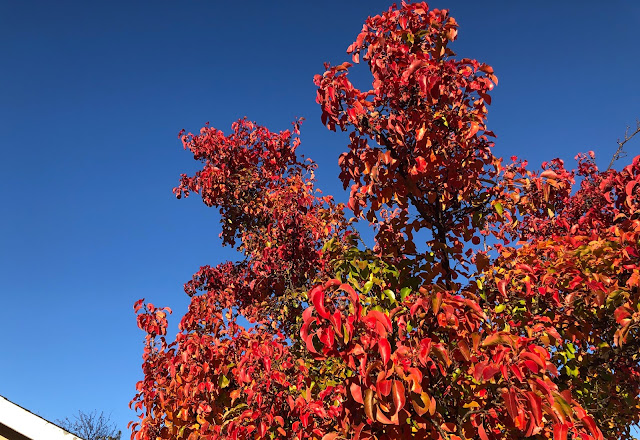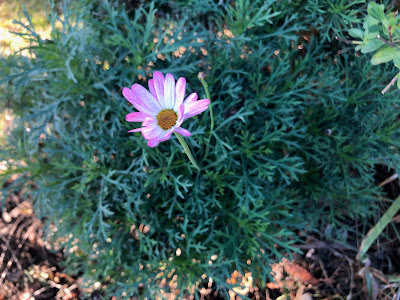
A very quiet Thanksgiving, inside and out

|
|
It's not a perfect tree by any means, but this Pyrus puts on a good show in fall.
(Photos: Kathy Morrison)
|
The sky is bright blue this Thanksgiving Day, the temperature mild. The only activity is from the gusts of wind blowing many of the leaves off the trees and into the yards.
When I went out front this morning, I turned back to look at my house. The flowering pear tree ( Pyrus calleryana ), which still has most of its leaves, seemed particularly ablaze with all shades of red and orange, accented by green and yellow closer to the trunk. This show of color, I recalled, is why I planted the tree almost 20 years ago, even though it has since made me a little crazy by sending up suckers all over.

|
|
One pink marguerite blossom, a reminder of summer and
a promise for next year.
|
The gifts of nature can be obvious or subtle, but they are gifts to cherish, especially this year.
I have never been more grateful and happy to be a gardener. In 2020, gardening has been my lifeline, something to hang onto while the outside world was turning upside down. Seeds planted still sprout and produce food, for humans or for the wildlife. Flowers bloom, even when the air is too smoky for humans to breathe. Trees turn color unprompted.
Last Thanksgiving, I put together a list of things that gardeners can be thankful for, which I will recap here, since they are still relevant, of course. There's just a small update.
I am thankful for:
-- Pollinators who do their thing in the garden on their own time, and do even more with a little encouragement (and plants they love). From almonds to zucchini, the area's crops and our home gardens depend on the bees, birds, butterflies and other insects.
-- The trees that shade our homes and give us mulch in the fall, as well as provide food -- even if just for wildlife (oh, those squirrels!) -- and homes for birds.
-- The magical soil below us, full of nutrients and microbes and earthworms and so many things we're not aware of as we walk over it.
-- Our gorgeous Mediterranean climate, which even as it's changing lets us work outside nearly year-round and grow so many things so well that we're the envy of the rest of the country's gardeners.
--The wonder of tiny seeds that turn into 2-pound tomatoes with just the right amount of care.
-- Finally, the generosity of fellow gardeners, who give freely of seeds, plants, produce, tools and advice. If someone says, "Oh, you're a gardener, too!" you have instant rapport. And this year, my community widened with all my new master gardener colleagues, including my Zoom-assisted Class of 2020. (Congrats to us! Hope to see you all in person again someday.)
Happy Thanksgiving, everyone. Stay healthy and keep gardening!
Comments
0 comments have been posted.Sacramento Digs Gardening to your inbox.
Food in My Back Yard Series
May 6: Maintain soil moisture with mulch for garden success
April 29: What's (already) wrong with my tomato plants?
April 22: Should you stock up on fertilizer? (Yes!)
April 15: Grow culinary herbs in containers
April 8: When to plant summer vegetables
April 1: Don't be fooled by these garden myths
March 25: Fertilizer tips: How to 'feed' your vegetables for healthy growth
March 18: Time to give vegetable seedlings some more space
March 11: Ways to win the fight against weeds
March 4: Potatoes from the garden
Feb. 25: Plant a fruit tree now -- for later
Feb. 18: How to squeeze more food into less space
Feb. 11: When to plant? Consider staggering your transplants
Feb. 4: Starting in seed starting
Sites We Like
Garden Checklist for week of May 4
Enjoy this spring weather – and get gardening!
* Plant, plant, plant! It’s prime planting season in the Sacramento area. Time to set out those tomato transplants along with peppers and eggplants. Pinch off any flowers on new transplants to make them concentrate on establishing roots instead of setting premature fruit.
* Direct-seed melons, cucumbers, summer squash, corn, radishes, pumpkins and annual herbs such as basil.
* Harvest cabbage, lettuce, peas and green onions.
* In the flower garden, direct-seed sunflowers, cosmos, salvia, zinnias, marigolds, celosia and asters. (You also can transplant seedlings for many of the same flowers.)
* Plant dahlia tubers. Other perennials to set out include verbena, coreopsis, coneflower and astilbe.
* Transplant petunias, marigolds and perennial flowers such as astilbe, columbine, coneflowers, coreopsis, dahlias, rudbeckia and verbena.
* Keep an eye out for slugs, snails, earwigs and aphids that want to dine on tender new growth.
* Feed summer bloomers with a balanced fertilizer.
* For continued bloom, cut off spent flowers on roses as well as other flowering plants.
* Add mulch to the garden to maintain moisture. Mulch also cuts down on weeds. But don’t let it mound around the stems or trunks of trees or shrubs. Leave about a 6-inch to 1-foot circle to avoid crown rot or other problems.